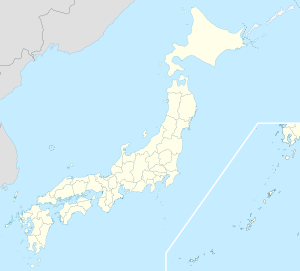Ikoma
| Ikoma-shi 生 駒 市 |
||
|---|---|---|
| Geographical location in Japan | ||
|
|
||
| Region : | Kinki | |
| Prefecture : | Nara | |
| Coordinates : | 34 ° 41 ' N , 135 ° 42' E | |
| Basic data | ||
| Surface: | 53.18 km² | |
| Residents : | 116,816 (October 1, 2019) |
|
| Population density : | 2197 inhabitants per km² | |
| Community key : | 29209-5 | |
| Symbols | ||
| Flag / coat of arms: | ||
| Tree : | Quercus gilva | |
| Flower : | Chrysanthemums | |
| town hall | ||
| Address : |
Ikoma City Hall 8 - 38 , Higashishinmachi Ikoma shi Nara 630-0288 |
|
| Website URL: | http://www.city.ikoma.lg.jp/ | |
| Location Ikomas in Nara Prefecture | ||
Ikoma ( Japanese 生 駒 市 , - shi ) is a city in the northwest of Nara Prefecture in Japan at the foot of the Ikoma . 116,816 people live in Ikoma (as of October 1, 2019) in an area of 53.18 square kilometers, which makes it the third largest city in the prefecture. The cities of Nara , which is also the seat of the prefectural administration, and Kashihara have more inhabitants than Ikoma .
history
Ikoma was a fiefdom ( 生 駒 庄 , Ikoma-shō ) during the Muromachi period in which the noble family of the same name resided. When the Japanese community system was reformed on April 1, 1889 according to the western model, the villages ( mura ) Yamasaki ( 山崎 村 ), Tanida ( 谷 田村 ), Tawaraguchi ( 俵 口 村 ), Kōmyō ( 小 明 村 ), Tsuji ( 辻 村 ) and Nabata ( 菜 畑 村 ) in the district of Heguri amalgamated to form the municipality of Kitaikoma ( 北 生 駒 村 , "Northern Ikoma"). On April 1, 1897, the districts of Heguri and Soejimo merged to form the district of Ikoma . On February 11, 1921 Ikoma was raised to a district city ( chō ). On March 10, 1955, the village of Minamiikoma ( 南 生 駒 村 , "South Ikoma") and on March 31, 1957 Kitayamato ( 北 倭 村 ) was incorporated. On November 1, 1971, Ikoma became an independent city ( shi ).
geography
Ikoma is located in the western part of Honshūs , the main island of Japan and at the foot of the Ikoma , which at 642 meters is also the highest mountain in the mountain range of the Ikoma mountainous region. The image of the city shows the Ikoma in the background, recognizable by the large number of transmitter masts.
The third largest city in the prefecture is located west of the city of Nara and east of the city of Osaka , in the Kansai cultural landscape and the Kinki region . In its wider area lie the port city of Kobe to the west and the city of Kyoto to the north. Both cities are about 50 kilometers from Ikoma.
traffic
| Streets | Train connections |
|---|---|
| National Road 163 | Kintetsu Nara line |
| National Road 168 | Kintetsu Ikoma line |
| National Road 308 | Kintetsu Keihanna lineage |
Neighboring cities and communities
| Nara prefecture | Kyoto Prefecture | Osaka prefecture |
|---|---|---|
| Nara | Kyōtanabe | Hirakata |
| Yamatokōriyama | Seika | Daitō |
| Ikaruga | Higashiōsaka | |
| Heguri | Shijonawate | |
| Katano |
Personalities
- Kyōgo Furuhashi (* 1995), football player
Web links
- Official Website (Japanese)
Individual evidence
- ↑ 生 駒 氏 . In: 日本 大 百科全書 (ニ ッ ポ ニ カ) at kotobank.jp. Retrieved November 15, 2016 (Japanese).
- ↑ Kintetsu: Railway Business, p. 6 ( Memento of August 8, 2011 in the Internet Archive )




